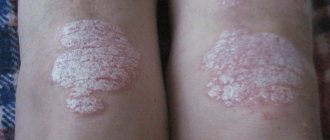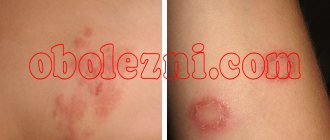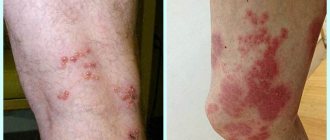admin Home page » Types of herpes Views: 837
( 1 ratings, average: 5.00 out of 5)
Herpes is a fairly common and unpleasant disease. Most people know that there is a virus of oral and sexual origin.
But, very often, herpetic lesions can appear in other parts of the human body. The disease is accompanied by rashes, itching, and sometimes headache. Herpes disease can even appear on the folds of the neck.
The causative agent of infection
The appearance of a characteristic rash on the neck can be caused by one of two types of viruses:
- Herpes simplex (HSV type 1). The infection usually appears on the lips, but sometimes spreads to other organs.
- Varicella-Zoster virus (HSV type 3). If the virus enters the body for the first time, chickenpox develops (usually in childhood). A severe weakening of the immune system in an adult who has had chickenpox in childhood leads to the appearance of herpes zoster.
The pathogen spreads along the affected nerves, causing rashes.
Features in children
It is not immediately possible to recognize shingles in children, since the rash appears after the immune system has weakened. The disease develops at a slow pace, but neoplasms spread throughout the body quickly and acutely. At the initial stage of the disease, parents often confuse herpes zoster with an acute respiratory viral infection, as characteristic symptoms are observed: a general deterioration in the child’s health, the appearance of chills, increased body temperature, decreased appetite, and a burning sensation and itching.
The symptoms of the disease vary from person to person, so the signs of shingles may vary.
Clinical picture
Herpes viruses types 1 and 3 have both common symptoms and differences. Timely recognition of the first signs of the disease will allow us to determine the specific type of infection and begin adequate therapy.
Symptoms of herpes simplex virus
The first manifestations of the disease are not immediately noticeable. First, small areas of skin on the neck turn red, and a tingling and itching sensation appears.
One of the most common signs of herpes on the neck is enlarged lymph nodes, but this symptom does not appear in all cases.
Subsequent stages of the disease are accompanied by the following symptoms:
- A day after the first symptoms appear, blisters filled with clear liquid begin to appear on the reddened skin.
- Gradually, the bubbles enlarge and become larger, and the liquid inside them becomes cloudy.
- The bubbles burst and their contents come out.
- Bursted blisters become covered with a hard crust, which indicates the beginning of recovery. Treatment cannot be interrupted at this stage.
You should consult a doctor immediately after the appearance of severe and persistent itching in the neck area (bubbles will appear in 10-14 days). Treatment of the infection started in the first stages will allow you to quickly get rid of its manifestations.
Symptoms of herpes zoster
There are several stages in the development of the disease:
- A severe headache appears. The patient feels unwell and chills. Symptoms may persist for 72 hours, and sometimes longer.
- In the area of future rashes, a feeling of itching and burning appears.
- Appetite is disrupted and temperature rises.
- The affected area on the neck begins to swell, spots with a diameter of about 3-4 mm appear.
- Within 24 hours, the spots turn into vesicles with serous contents.
- After a day, the swelling decreases slightly, the liquid in the blisters becomes cloudy.
- The rash begins to dry out and a crust forms in place of the burst blisters.
- The patient’s general well-being improves and the temperature normalizes.
Depending on the state of immunity, symptoms of the disease may manifest themselves differently.
If the disease proceeds normally, recovery occurs approximately 3 weeks after infection. When the rash on your neck goes away, the hyperpigmented areas will remain.
Symptoms of different forms of the disease
Today there are seven main forms of the disease, each of which has its own symptoms and characteristic features:
- gangliocutaneous is the most common form of the disease, which is characterized by an acute initial stage, which occurs with intoxication symptoms, including debilitating pain in the affected area and rashes on the skin. As the disease progresses, blistering formations with a clear, gradually becoming cloudy liquid appear. After a certain time, the new growths dry out and transform into a crust;
- ocular – localization on the face, eye or nose. Rashes appear followed by blistering formations. The affected areas of the body turn red and cause a lot of pain to the owner of the disease. If the eye is affected, temporary blurred vision may occur;
- auricular - localization of formations is inherent in the skin in the area of the auricle or ear canal. This form is dangerous because it can cause paralysis of the nerves located on the face. Shingles of the third form is characterized by an acute initial stage, which occurs with intoxication symptoms, including debilitating pain in the affected area and rashes on the skin;
- necrotic. Characteristic features of this form are deep lesions of the epidermis with subsequent scar formation. The development of bubbles occurs in the eyelids, temples, nose and forehead. The gangrenous form lasts for 2 weeks;
- meningoencephalitic - is extremely rare, but is the most dangerous form, as it is characterized by lethal outcomes. At the initial stage of development, the intercostal nerves and skin in the neck area are affected. Then ataxia, hallucinations, paralysis of the limbs occur, the muscle tone of the neck increases, which leads to difficult movements of the head, and “Kernig syndrome” occurs. Having reached its peak of development, it is possible to fall into a coma. The listed symptoms can develop in a time interval of 2-21 days from the moment the rash appears;
- generalized. This form is characterized by the formation of single or multiple vesicular neoplasms on any area of the skin, not excluding the mucous membranes. Symptoms include: fatigue, fever, weakness. Due to the fact that the symptoms of the generalized form are similar to chickenpox, the diagnosis may not be made correctly. If after 2-3 weeks there is no complete recovery, there is a place for concern (the neoplasm may be of poor quality);
- abortive is the most harmless form of the disease in the absence of blistering formations. Only small amounts of redness and rash occur, which are accompanied by a slight burning sensation and itching. The period of passage of the disease, as a rule, is no more than four days.
Diagnostic methods
To determine herpes on the neck, the following diagnostic methods are used:
- Dermatological examination. Herpes manifests itself with characteristic symptoms, so in most cases this method makes it possible to make an accurate diagnosis.
- Linked immunosorbent assay. When a herpes virus enters the body, it begins to produce specific antibodies that are easily detected using ELISA. Blood or cerebrospinal fluid is taken for testing.
- PCR. This method is used to determine the DNA of the virus in the sample being tested.
- Culture method. It is used for chronic and latent forms of the disease.
How to treat shingles
It is not uncommon for a skin disease to go away without medical intervention. But in order to prevent complications, it is necessary to take appropriate measures. Therapeutic methods will eliminate the disease, relieve you of pain and prevent the occurrence of consequences in the early stages of the disease. When visiting a doctor, the specialist usually prescribes the following medications:
- “Ibuprofen”, “Aspirin” and “Oxidane” - to relieve pain;
- "Acyclovir" or "Famciclovir" - to destroy viruses;
- To relieve the inflammatory process, general corticosteroids are prescribed;
- If the doctor is faced with a depressed patient, antidepressants are prescribed to suppress the hormones produced.
Treatment is also carried out using ointments with anti-inflammatory, antiviral or analgesic effects. To restore the activity of nerve endings, physiotherapy or acupuncture is prescribed.
Treatment
Treatment of herpes on the neck is carried out using drugs for topical and oral administration. Complex therapy should include the use of traditional medicine.
Local preparations
Herpes on the neck is treated with external remedies that are applied to the affected area. The doctor prescribes ointments and creams based on acyclovir. They should be applied to clean skin at least 5 times a day. These remedies are most effective when treating the disease in its early stages.
After the blisters burst and ulcers form, antiseptic solutions are used that prevent the addition of a bacterial infection (Fukorcin or hydrogen peroxide).
Oral medications
To treat herpes on the neck, the doctor prescribes the following medications:
- Antiviral agents. They reduce the activity of the virus, eliminate the symptoms of infection, and prevent the development of complications (Acyclovir, Famvir, Valtrex).
- Antipyretics and painkillers. Significantly alleviate the course of the disease (Ibuprofen, Paracetamol).
- Immunostimulants. Help strengthen the immune system, activate the production of antibodies (Cycloferon, Viferon).
- Vitamin supplements. They have a general strengthening effect on the body weakened by infection.
ethnoscience
Herpes on the neck can also be treated using alternative medicine. The most effective are the following:
- Honey, ash, garlic. Mix honey (1 tablespoon) with ash (1 tablespoon) and chopped garlic (3 cloves). Treat the affected areas with the resulting mixture. Use the remedy until complete recovery.
- Calendula. Squeeze the juice from the inflorescences (1 tbsp) and mix with Vaseline (1 tbsp). Apply the ointment to the affected areas. Instead of fresh petals, you can also use dried raw materials, previously crushed to a powder.
- Vegetable oils. Treat the affected areas with sea buckthorn, olive or fir oil several times a day.
- Juice of Kalanchoe, lemon, aloe, aspen leaves. Apply fresh juice to the rashes several times a day. Use the remedy until complete recovery.
- Soda. Boil water (0.5 cup) and add soda (1 tbsp). Apply the solution to the rash. Using this product may cause severe pain.
- Garlic. Peel a clove of garlic, cut it into two halves and rub the rashes with fresh juice. Carry out the procedure every 2 hours. Before going to bed, soak a cotton swab in garlic juice and apply a compress for 10 minutes.
Personal hygiene, daily routine and diet of the patient
To speed up the healing process, you need to follow several rules:
- Isolate the patient from other family members, as the herpes virus is very contagious.
- Do not self-medicate.
- Strictly follow all doctor's recommendations and take medications in a timely manner.
- Monitor your diet - exclude salty, fatty, fried foods from your diet. It is recommended to consume fresh vegetables, fruits, dairy products and grains.
- Comb your hair only with a wide-toothed comb, which has been pre-treated with an antiseptic. During the procedure, the skin of the neck should not be touched.
- Use only personal bath accessories, bed linen and other household items.
- After each contact with areas of the body affected by herpes, you should thoroughly wash your hands. This will help prevent the infection from spreading to healthy areas.
Regular walks in the fresh air are beneficial. It is recommended to do frequent wet cleaning of the house and to ventilate the room.
Features in adults
Skin disease is more common in adults. This is due to the fact that sexually mature people have more reasons to give rise to shingles. Constant stress associated with professional activities, personal life, previous infectious diseases and other reasons serve as an impetus for the development of the disease.
A special feature is that an adult has no restrictions on treatment methods; his age allows him to take all measures to eliminate the disease, be it a folk remedy or medical intervention.
The disease in the adult generation is much more severe, since shingles is accompanied by debilitating headaches, tingling in the damaged area, low-grade fever, pain at the slightest contact with tumors, severe burning and itching, while in children there may be a complete absence of symptoms.
Is herpes on the neck contagious?
Herpes is a highly contagious disease, regardless of where the rash is located. The risk of infection persists as long as the rash remains on a person’s skin.
There is no fear of infection after the bubbles with liquid burst and crust over.
The fluid filling the blisters is the source of infection. If a person touches the rash and then touches objects accessible to other people, there is a possibility of infection.
Who develops complications and when?
Hidden asymptomatic carriage of the virus that causes herpes zoster in adults is observed in 15% of the population of the former CIS countries. After chickenpox in childhood, the virus goes into a dormant form and continues to persist in the nerve ganglia of various nerves.
After a long time, when a person’s immunity decreases due to natural (age) or acquired causes, herpes reactivates and causes herpes zoster. This is a syndrome that is accompanied by pain and a characteristic rash (vesicles on reddened skin).
Those at risk of contracting herpes zoster and developing severe complications include:
- People over 50 years of age who had chickenpox in childhood. At a certain age, this category of people experiences a natural physiological decline in immunity.
- Patients of any age who have been diagnosed with HIV infection. HIV is a disease that is accompanied by suppression of the immune system. Herpes zoster in young and middle-aged people is considered a marker of HIV.
- In women with severe complicated pregnancies. During pregnancy, moderate natural immunosuppression occurs, hormonal levels change and the herpes virus is easily reactivated.
- Patients with decompensated and oncological diseases.
- People receiving immunosuppressive therapy (cytostatics, etc.).
Prevention measures
To prevent the development of herpes on the neck and avoid repeated relapses, you need to follow simple preventive measures:
- wash your hands with soap every day after returning from the street and contacting strangers;
- harden the body and strengthen the immune system;
- lead a healthy lifestyle, eat right;
- avoid contact with people with herpes;
- give up bad habits that can weaken the body’s protective functions;
- take regular courses of vitamin supplements during the period of decline in the body’s immune forces (spring-autumn).
Timely treatment and adherence to personal hygiene rules will quickly get rid of the signs of herpes on the neck, and a healthy lifestyle and strengthening the immune system will prevent the disease from reoccurring.
How to distinguish it from other diseases with a rash
Skin rashes and general malaise are symptoms common to a large number of other diseases. Manifestations of herpes on the neck are often confused with the following problems:
- colds;
- allergy;
- rubbing with clothes that are too tight;
- failure to comply with personal hygiene rules;
- hormonal fluctuations;
- wrong diet;
- gastrointestinal diseases;
- other viral diseases (rubella, measles).
The easiest way to determine that it is herpes is by the following distinctive features:
- Characteristic rash. Cases of skin rashes with blisters are characteristic only of herpes (if we consider common mass diseases).
- Shooting pains of a neuralgic nature, radiating to the head, arm or chest.
- The rash is one-sided - it appears either on the right or on the left.
If the listed symptoms are observed together, it is almost guaranteed to be herpes.
How dangerous is herpes zoster?
This pathology conceals a great danger, because due to incorrect or untimely treatment, it causes serious complications. They are quite capable of affecting various internal organs, disrupting their full functioning and creating foci of infection in them.
The most terrible complications after suffering from herpes zoster are neurological disorders (especially if the peripheral nervous system is affected). At the same time, the brain often swells, which in the advanced phase often leads to death, so be attentive to the alarm signals that your body gives.
We recommend! No more rashes, itching, burning and other symptoms of HERPES! Our readers have been using this method to treat herpes for a long time. Continue reading >>>
Herpes zoster: causes of the disease
As noted, the appearance of herpes is caused by the Herpesvirus Varicellae virus. The properties of this pathogenic microorganism are similar to the characteristics and characteristics of other representatives of the family of viruses in question.
Firstly, the causative agent of herpes zoster does not tolerate various aggressive external influences well, or does not tolerate them at all. Thus, the virus dies even with short-term (up to 10 minutes) heating, under the influence of ultraviolet rays, disinfectants and special preparations.
Secondly, the causative agent of herpes zoster normally resists cold. Even with repeated freezing, this microorganism does not lose its harmful properties.
Most often, herpes zoster occurs in older people.
The peculiarities of the virus are such that the symptoms of herpes zoster will appear in the patient only if he has previously had chickenpox in its latent or typical form. No epidemic outbreaks of the disease have been recorded - cases of the disease remain exclusively at a sporadic level.
Most often, herpes zoster occurs in elderly patients, but cases of the disease developing in young people are periodically observed.
By its nature, the causative agent of the disease in question is a contagious infection. So, if a child who has not previously had chickenpox comes into contact with a carrier of the virus, after a certain time (usually up to 3 weeks) he will most likely develop chickenpox.
Thus, the shingles virus is a contagious disease and is transmitted by airborne droplets.
The shingles virus is a contagious disease and is transmitted by airborne droplets.
People who have previously had chickenpox retain a certain amount of the causative viruses in their bodies. A confluence of various unfavorable circumstances can lead to their awakening. As a result, inflammation will develop in places where pathogenic microorganisms are localized, with the manifestation of all the symptoms characteristic of this.
Among the key reasons that can lead to the awakening of the dormant herpes zoster pathogen, the following should be noted:
- nervous overstrain;
- deterioration of immunity under the influence of various types of chronic and acute diseases, including HIV and AIDS;
- hypothermia;
- injuries;
- neoplasms in the body, etc.
Possible complications
Getting shingles is unpleasant in itself, but the troubles don't end there. Often, photographs of patients with this disease are supplemented with signs of deep skin damage, and if the lichen rash is localized on the face, with signs of damage to the facial nerve. Cases of paralysis, paresis, and hallucinations have also been recorded.
What other manifestations of herpes are possible?
The pathological process involves the mucous membranes, possibly affecting the pleura, brain and internal organs, most often the bladder and rectum.
Rarely, ophthalmic herpes occurs - ocular and ear herpes ; it used to be called Hunt's syndrome. With it, bubbles form externally on the concha and in the ear canal, on the eardrum and even on the lateral surface of the tongue, accompanied by intoxication, fever and neuralgia with a specific set of symptoms: changes in taste, slight nasality, tinnitus, increased headache when turning the head, dizziness.
Photo of herpes zoster
This is what herpes zoster looks like in the photo
Infection affects nerve tissue
Herpes zoster appears on the body in the form of such rashes











